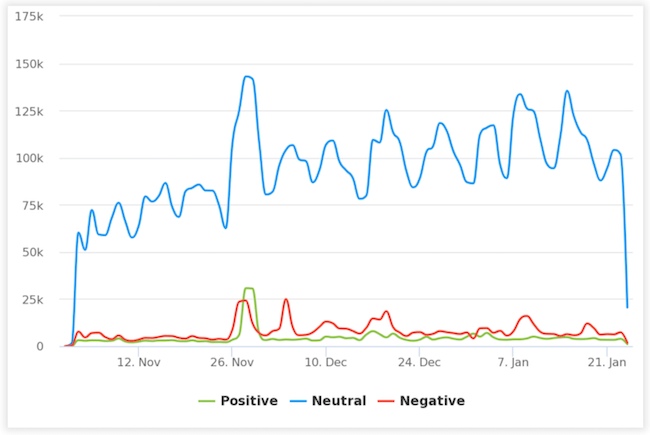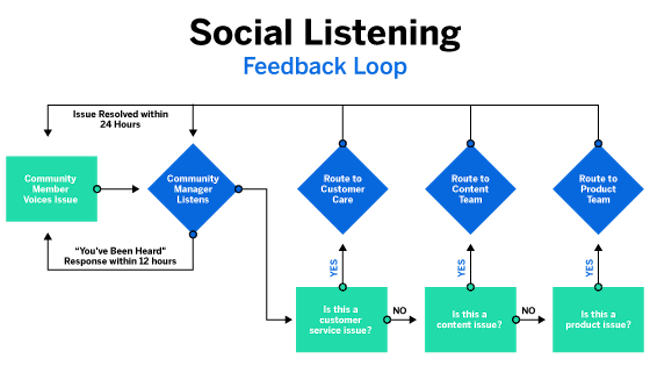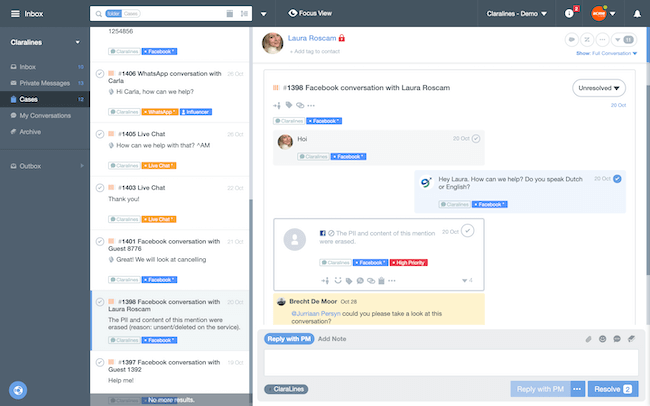
Brand Experience
Social listening: What it is and why it matters
Updated August 23, 2024
As one of the best ways to understand what people are really saying about you in their environment, social listening should be an integral part of your brand strategy. Here’s how it works.
Social media platforms are a treasure trove of data that can help you understand what people are saying about a chosen topic, which you can use to improve the experience for your customers, employees, product, and brand.
In order to harness the power of this data, it’s important that first, you listen. Which, naturally, is what social listening is all about.
But what exactly is social listening, and how can social listening tools help you to understand your customers more deeply? Even more importantly, how can you make sure your social media listening tools are worth your time and money?
Learn about Quatrics' social listening tools
What is social listening?
Social listening is where you track conversations and mentions related to a chosen topic on social media platforms, and then analyze them for insights into what actions you can take that will improve the experience. More specifically for brands, social listening is the process of understanding the online conversation about your brand, as well as your products and services.
These conversations and mentions may be directly aimed at the brand (talking or replying to your brand), or they may be broader where the brand is not directly mentioned (talking about your brand).
Social listening as a concept has been around for decades. People regularly request feedback via surveys and other means. But with advances in technology, it’s now possible to surface this seamlessly from social media channels without having to ask, meaning you can effortlessly collect rich data at scale.
Effective strategies require continuous social media monitoring because by doing so you can constantly learn and uncover new insights, and continue to improve your business based on what users are saying. It should not be treated as a “moment in time,” rather, just like social media itself, monitoring should be “always-on.” That way, if sentiment or trends shift, you have your finger on the pulse and you can adapt quickly where needed.
Social media monitoring in this way can be performed manually - but rather than your customer service team sifting through social media data by hand, you can use social listening tools to help you.
What’s the difference between social listening and social monitoring?
In order to listen, you need to monitor social media channels. Social media monitoring on its own is more passive than social listening and typically involves identifying and responding to individual mentions. Like social listening, it is a form of reputation management, but it is less focused on action because it only tracks metrics. For example, social media monitoring might track:
- Brand mentions
- Relevant hashtags
- Competitor mentions
- Industry trends
- Keywords
Keyword monitoring as part of your social listening strategy is particularly important during a crisis when a brand wants to collect all coverage related to that incident.
Social listening goes one step further and takes action on the data you have collected. It is more active because it analyzes the data and provides insights that will help you make better customer-focused decisions as a business.
Why is social listening important?
Social media is no longer a platform where you can push farmed content to followers and expect them to be ecstatic to engage with you. Social listening allows you to understand what your customers are talking about, what they think, how they feel, and what they need from your business. The trick is listening to what is being said in context. Getting context around what your followers are saying about you means being able to listen to them speak in real-time, pair that data with information about the customers themselves and apply the sentiment to it to make strategic business decisions.
This is where social listening comes into play. With the right social media marketing tools, social listening will allow you to track the conversations around specific phrases, words, emojis, and terms relevant to your business, and apply context to them in order to understand how people are speaking about your brand on social media.
When done right, this also allows you to be able to craft conversations and use tones that are most likely to resonate with them. It also empowers your team to make strategic decisions that will best benefit your company.
By meeting the customer where they are, rather than relying on direct survey data, you can really get to the heart of what people are saying about you - without having to ask. Therefore it is an alternative, and valuable, source of feedback.
Knowing this information, you can be confident in the actions you take to address these insights, with peace of mind that your decisions are for the good of the customer and will improve your business. There is less risk involved too.
A social listening strategy can improve the whole experience of your business, including customer, employee, product, and your brand.
When to use social listening
Social listening data has multiple uses. We’ve outlined a few below.
Reputation management
Brands need to make sure the experience they provide is in line with their reputation. If there is discord between the two, then the brand will suffer because there will be an “experience gap.” During a crisis, this reputation can be tarnished - sometimes permanently. This is why reputation management is so important. If something has gone wrong for your brand, you need to know about it and fix it quickly. Typically, if there is a problem with your reputation or a crisis, then it signals that there is an issue with the experience that needs to be addressed.
Tracking and analyzing brand sentiment is a really helpful benchmark for assessing your reputation. If sentiment towards your brand is falling, then something you are doing is at odds with the experience your customers expect and your reputation is being impacted as a result. Analysis of brand sentiment will give you an idea about what that is.

This is also very valuable in a crisis because you track and analyze the sentiment and engagement of particular keywords associated with that crisis.
Alternatively, if sentiment is rising you’ll be able to see what’s working and can look to build on that.
Competitor analysis
Social media listening will allow your team to understand how you benchmark against your direct and indirect competitors. With this information at the ready, your insights team will be able to look beyond market-share to identify competitors and see where your business falls short in other areas of the business such as customer service, customer retention, reputation, and other factors.
You’ll also be able to see where you excel in your industry. Do you have the best product? Are you untouched when it comes to timely deliveries? Do you offer the most in terms of cost savings? Knowing where your company falls behind and knowing where you exceed customer expectations will further allow you to perfect the areas you’re already succeeding in and to build a plan around the areas that are in need of improvement.
You’ll be able to answer: Who are your main competitors? What are they doing well? What are they doing not so well? How much of the market do they dominate?
By tracking and analyzing your competitors, and their relevance to you, you can stay one step ahead and ensure you differentiate yourself from the rest and create or maintain your competitive advantage.
See how you stack up against your competitors with our Competitive Research Service
Engage with your customers
Some of the best marketing campaigns have used social media listening as a key part of their strategy. By listening to your customers, and identifying advocates or critics of the brand, you can listen to what they have to say and use this opportunity to create a conversation and a moment that brings the community together.
From consumer FMCG goods to football signing announcements, or brand product campaigns (like Apple’s Shot on iPhone campaign), social listening provides an opportunity to be creative and elevate the brand. As an example, many brands, such as Innocent Drinks, have actually highlighted critics of product features, fixed what was broken, and then used this feedback in tongue-in-cheek style to highlight the improvement of their product.
innocent super smoothies: The Final Re-Re-Re-Re-Re-Re-Re-Re-Re-Rebrand
More vitamins than you can shake a stick at.
More label redesigns than we know what to do with.
And just three months later than we originally planned.Please don't tell our boss. pic.twitter.com/V5ZJ0Twuxs
— innocent drinks (@innocent) June 29, 2020
Campaigns and strategies such as these drive engagement and humanize your brand because, by nature of the concept, it shows you listen to them.
Alternatively, you can drive engagement with customers by providing better support to customers online. By listening, and acting to rectify any issues a customer may come onto social media with, a brand can quickly turn a bad experience into a good one.
Identify and leverage your influencers
Social listening will also help you to identify influencers in your industry. Why are these important?
1.) Most consumers rely on social media to guide their decisions to move forward with the purchase of a product or service.
2.) Consumers are more likely to trust peer reviews rather than advertisements.
You might be surprised at who the true influencers in your industry are. You might find that only a handful of people or sources influence the decisions that your consumers make. On the other hand, you might find that your influencers aren’t the individuals making the purchase.
By finding out who your true influencers are, you can use the tools to monitor how they talk about your brand, or what they’re saying about other brands similar to yours. Furthermore, you’ll be able to proactively anticipate the questions that people will have about your brand so that you can ensure you’re answering those questions through every medium you can, while also making accurate information accessible to influencers, whoever they may be.
Hunt down and fix experience gaps
As the customer engagement point alludes to, social listening is another stream of feedback that can help you to identify problems with the experience - whether that’s for customers, employees, or the product and brand experience. This might be a 1 to 1 problem like a late delivery, or a more significant, wider issue - such as repetitive product feature issues.
Knowing this information in real-time means you can work with the relevant teams and departments in your business to fix these as quickly as possible.
Other use cases of social listening include:
- Crisis management
- Customer service
- Customer satisfaction
- Brand health and reputation
- Content creation
- Marketing campaign performance
- Trend and demographic insights
- Business pitch research
(Brandwatch)
What metrics to track using social listening
There are many metrics you can track, each of which is useful if used in the right context.
Share of voice - tracking mentions and references to your business, in comparison to your competitors will help you to determine how much of the conversation you own and your relevance or position in the industry. You’ll be able to see what your audience is saying about them too.
Engagement rate - The rate at which users interact with your content upon seeing it. Engagement covers multiple actions users might take on social media including retweets, likes, shares, direct messages, comments, and follows. Within this, you might look at seasonal changes, differences between demographics, and sudden spikes or drops in mentions.
Engagement is closely tracked because it can lead to building a profitable relationship between you and the user. The more engaged a user is, the more likely you are to be able to convert them into a customer. High engagement can indicate trust, enthusiasm, interest, and enjoyment of the brand, although it should be noted that high engagement won’t always be positive. For example, replies may have a negative sentiment attributed to them.
Sentiment analysis - This leads us onto the next metric that you can track - sentiment of your brand. Using natural language analysis, you can assess whether people talking about/to your brand are positive, negative, or neutral. Analyzing how sentiment changes over time can be used as a good indicator of shifts in customer satisfaction. If sentiment is increasingly positive, then you can see if satisfaction is also rising, meaning you are doing a good job of meeting the needs of your customers.
Conversion rate - Social listening is vital if you want to align your customer experience to your business goals. By understanding what really matters to your customers through social listening, you can take steps to meet these needs. Conversion rate is a good metric to track this. For example, the more people you get through to the website, the more likely it is that you are effectively showing your audience that you can meet their needs.
How to use data gathered from social listening
Social listening should be aligned with your business goals. When analyzing the data you gather, look for trends, patterns of behavior, and key drivers of the data you are seeing, and see how these insights can help you meet these goals. For example, if people are saying your in-store experience is poor and satisfaction is suffering, as a result, look for the reason why. Perhaps people are saying the lines are too long?
As with any source of feedback, how you not only analyze but act on this data is essential. Attributing metrics (such as sentiment) to certain goals (such as increasing customer satisfaction), means you can take action on the feedback you receive, knowing that this will help you to achieve your goals.
Perfecting the customer experience is a likely outcome from social listening. You can use the data to drive strategic business changes. Changes might include messaging, product descriptions, product price, improvements to services and generally making it easier for people to do business with you.
By listening on social media, you can uncover not only what customers think but why they think it. For example, maybe you rolled out a new promotion giving customers a discount, but your sales registers aren’t up to date in processing that promotion. Confused customers are likely to turn to social media to complain that your promotion is bogus, but this also gives you the chance to fix it before too many customers experience the problem. This sort of efficient feedback loop is supported by real-time social listening and taking action.

Connect with your customers with our free Qualtrics survey templates
Tools to help with social listening
Your social listening tools should have integrations that can fuel your social media strategy, chart your online presence, track your progress and see your social media data as part of the bigger business picture.
Here are two integrations that help Qualtrics’ social listening tool to remain sophisticated and sensitive.
Qualtrics & Brandwatch
There are various tools that can help with social listening, and Qualtrics has an integration with a few partners - such as Brandwatch. Brandwatch is an expert in social listening and can help challenge your own perceptions of what you think is true by learning what your customers are actually saying about you and your competitors in their own context.
The platform gives “structure and meaning to the voices of billions of people, so you can make decisions that truly fit with consumer and buyer needs.” Brandwatch can also do scene analysis from sources such as pictures to help businesses understand the context in which they, and their competitors, are being consumed.
Its partnership with Qualtrics is a game-changer for any marketing professional. This is because your data from social listening gets pulled through into the Qualtrics platform, and analyzed to identify key insights, trends, and patterns of behavior. Based on this information, recommended actions are sent to the right teams to implement, designed for maximum impact and to help you reach your business goals.
Qualtrics & Clarabridge
Qualtrics, now powered by Clarabridge, enables companies to listen to all social data sources, gathering and analyzing customer data from any social media source and any online review site, including Facebook, Twitter, TripAdvisor, and Booking.com, among many others. Clarabridge also integrates data from social CRM tools and social media monitoring software such as Sysomos, Radian6, and many more for a comprehensive view. With this partnership, literally no mention of your product or company is left behind. We find it all.
Qualtrics and Clarabridge support finding the real feedback through what could otherwise be viewed as noise. Then Qualtrics’s platform understands the context of the mentions, supports deep analytics across the data, and ensures you can establish a rich social media engagement strategy.
Routing appropriate questions and responses to agents most likely to be able to assist customers ensures that customers are assisted and given appropriate information effectively and efficiently.
Categorization models most relevant to your business help you to bring context into how people may talk about your brand and business. As you use this, and the tools continue to track information, you’ll be able to better understand sentiment towards your company from the outside in. Often, businesses assess competitors by what they think they know about customers. The right tools will reverse engineer this so that your team is able to gather the information that you need to assess before making any decisions. For instance, a business may think that its influencers are parents, so it may just discern what parents are saying about it on social media. Categorization models would also bring to your attention the fact that schools, teachers, and students are the main influencers, although they may not be the ones making the actual purchase decisions.

How to measure social listening for ROI
To have a real shot of success, your company should be able to monitor trends and consumer behavior in their natural habitat, which may very well be on social media. Listen to the conversations they’re having, understand the terms most associated with your business, and be aware of the hashtags used and other business accounts often mentioned with your brand.
Qualtrics helps manage your brand, bringing social intelligence seamlessly into your in-house social CRM systems, workflow engines, engagement applications, and business intelligence tools. Through social listening, you can spot opportunities to fix negative experiences or capitalize on positive ones.
With the right social listening tools in place, you’ll be able to craft a winning social media strategy that is targeted enough to leverage the information uncovered in social listening, but agile enough to shift as you see consumer expectations and conversations evolve.
Rather than funding your social media marketing without a clear understanding of what brings you returns, you’ll be able to clearly see the ROI of your marketing campaigns with a social listening tool that’s sophisticated enough to pull social listening data into integrated dashboards. With financial oversight, you’ll be able to measure social listening for ROI easily.
Take control of your brand today with Qualtrics social listening tools